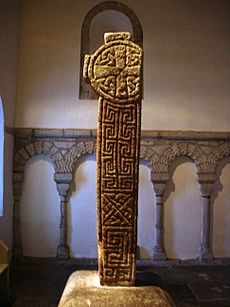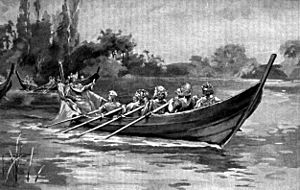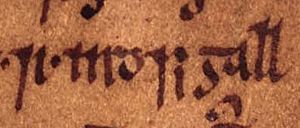Maccus mac Arailt facts for kids
Quick facts for kids Maccus mac Arailt |
|
|---|---|
| King of the Isles | |

Maccus' name as it appears on page 59r of Oxford Jesus College 111 (the Red Book of Hergest): "Marc uab herald".
|
|
| Successor | Gofraid mac Arailt |
| Dynasty | Uí Ímair (probably) |
| Father | Aralt mac Sitriuc (probably) |
Maccus mac Arailt was a powerful Viking leader who lived in the 900s. He was known as the King of the Isles, a group of islands between Ireland and Scotland. His family was called the Meic Arailt.
Maccus and his brother, Gofraid, first appear in historical records in the 970s. During this time, they led attacks against the Welsh people in Anglesey. They took advantage of fights between Welsh rulers. Maccus also met with King Edgar of England.
Later, Maccus turned his attention to Ireland. In 974, he defeated and captured Ímar, the King of Limerick. Maccus's brother, Gofraid, continued fighting the Welsh. Maccus was likely succeeded by his brother, Gofraid, who became the first King of the Isles mentioned by Irish sources.
Contents
Maccus's Family and Background
Maccus was part of the Meic Arailt family. It is believed his father was Aralt mac Sitriuc, who was the King of Limerick. If this is true, Maccus would have been a member of the Uí Ímair, a famous Viking family.
Maccus was likely the older brother of Gofraid. They might have had a sister named Máel Muire. She was married to Gilla Pátraic mac Donnchada, the King of Osraige in Ireland.
There is some confusion about Maccus's name. Some old texts called him "Magnus," but this seems to be a mistake. His name, Maccus, is probably from the Gaelic language.
Viking Raids in the Irish Sea
Maccus and his family, the Meic Arailt, became known in the Irish Sea region in the 970s. Their power likely came from controlling important trade routes. They may have been based in the Hebrides, a group of islands off Scotland.
The Meic Arailt wanted to control the Isle of Man. This might explain why they attacked the Welsh island of Anglesey. Anglesey was important because it was the home of the Welsh kings of Gwynedd. Controlling it would help the Meic Arailt control the sea lanes around it.
Historical records say that a son of Aralt attacked Anglesey. Other texts confirm it was Maccus himself. Maccus attacked Penmon, a significant religious site on the eastern coast of Anglesey. The next year, his brother Gofraid also attacked Anglesey and took control of it. The Welsh kingdom of Gwynedd was in a civil war at the time, which Maccus and Gofraid used to their advantage.
Meeting with King Edgar

Maccus likely attended a big meeting of kings with King Edgar in Chester in 973. After Edgar was crowned king, he gathered a large navy and met with several kings. Some stories say eight kings rowed Edgar down the River Dee as a sign of respect.
Maccus was one of these kings. Some old texts call him "prince of the pirates" or "king of many islands." These titles show how powerful Maccus was in the Isles.
The exact reasons for Edgar's meeting are not fully clear. It might have been a way for Edgar to show his power over his neighbors. He may have wanted to stop the Viking activity in the region, especially the Meic Arailt's attacks on the Welsh. These conflicts could harm English trade. Edgar might have sought an agreement with Maccus to keep the sea routes safe.
Edgar might also have wanted to prevent the Islesmen from helping unhappy groups in England. He may also have wanted to limit the power of Amlaíb Cúarán, the King of Dublin, who was a rival to the Meic Arailt. By easing tensions between Maccus and the Welsh, Edgar could have gained their support against Amlaíb Cúarán.
The Meic Arailt's attacks on Anglesey suggest they wanted to gain land in Britain. If Maccus controlled the Isle of Man, Edgar's large fleet might have been a show of force against him. This event could be seen as an example of "gunboat diplomacy," where a powerful navy is used to influence others.
Maccus's Later Actions

After the meeting with King Edgar, the Meic Arailt temporarily stopped their attacks in the Welsh region. They then turned their attention to Ireland.
In 974, Maccus, along with the "lawmen" (leaders) of the Isles, attacked Scattery Island. They captured Ímar, the King of Limerick. Ímar had become king of Limerick in the 960s. If Maccus was Aralt's son, this attack might have been a way for Maccus to reclaim what he believed was his family's rightful land.
Ímar might have been in control of Limerick when the people of Munster drove out the Viking rulers. Maccus might have demanded a ransom for Ímar, or Ímar might have escaped. Ímar later appeared in records three years later, when he was killed by Brian mac Cennétig. Brian's family and the Meic Arailt seemed to share a common enemy in Ímar.

The "lawmen" who joined Maccus's attack were likely elected representatives from the Hebrides. This shows that important leaders in the Irish Sea region received support from the Hebrides.
After Maccus's attack on Ímar, there is no record of the Meic Arailt until the 980s. In 984, the Meic Arailt formed an alliance with Brian mac Cennétig's family. They exchanged hostages, likely agreeing to work together against the Kingdom of Dublin. This alliance suggests that Brian's family wanted to unite the Vikings of the Isles against those in Dublin.
Maccus's brother, Gofraid, continued the Meic Arailt's attacks on the Welsh. In 978, Gofraid attacked Llŷn. In 980, Gofraid, along with a Welsh prince, attacked Llŷn and Anglesey.
The exact date of Maccus's death is unknown. He is not mentioned in records after 984. It is possible he died around this time, and Gofraid took over as King of the Isles. Gofraid's continued attacks on Anglesey suggest that any control the Meic Arailt gained over the Welsh was temporary.
In 980, Amlaíb Cúarán was defeated in a major battle and later died. While some Islesmen supported Amlaíb Cúarán, the Meic Arailt are not specifically mentioned as being involved.
Maccus's brother, Gofraid, is the first King of the Isles to be called "King of the Isles" by Irish historical sources. This happened when he died in 989. The rise of this kingdom might have been linked to Amlaíb Cúarán's defeat and the loss of Dublin to Irish control. The kingdom might have been a new creation, with the Meic Arailt gaining power over the Hebridean leaders. Later, Gofraid's descendants fought with Amlaíb Cúarán's descendants for control of the kingdom, which included the Hebrides and the Irish Sea region.






